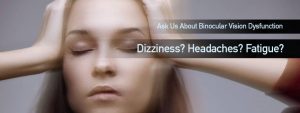More than 14 percent of adults in the U.S. complain of severe headaches or migraines.
A headache is described as an achy pressure in the forehead, temples and even the upper part of the neck.
A migraine is a severe headache that generally causes more debilitating symptoms. Migraines can cause nausea and make it difficult to speak and think clearly.
Can headaches and migraines cause visual problems?
Yes.
Headaches and migraines are common symptoms of binocular vision problems. They can also be symptoms of other types of visual conditions as well, such as computer vision syndrome (CVS) or near point visual stress (NPVS).
Vision problems can cause fatigue or eye strain that lead to a headache, especially after reading, or using the computer.
If you experience headaches or migraines often, contact a vision therapy eye doctor who can determine whether a binocular vision disorder is causing your pain.
What are binocular vision disorders?
Binocular vision disorders are conditions where the eyes are unable to align properly. This causes the eyes to overcompensate and overcorrect for the misalignment. This strains the eye muscles because they are constantly trying to re-align the eyes to eliminate blurriness and double-vision.
Two types of binocular vision disorders are binocular vision dysfunction and convergence insufficiency.
What is binocular vision dysfunction?
Binocular Vision Dysfunction (BVD) is a condition where the two eyes struggle to send one clear image to the brain due to a slight misalignment of the eyes.
Headaches occur as the brain attempts unsuccessfully to merge the images from each of the eyes.
What is convergence insufficiency?
Convergence insufficiency (CI) affects near vision and eye muscle coordination. Convergence of the eyes occurs when the two eyes need to focus on a close object, such as a book, computer, or smartphone.
Convergence insufficiency means the eyes struggle to focus easily for near tasks, affecting attention, school work, and office performance in adults.
If you experience severe headaches or migraines, contact an eye doctor near you, who can diagnose and treat the visual issues of this condition.
SEE RELATED: 2021 Update: BVD and Neck Pain
What are the best treatments for binocular vision problems?
Vision therapy and micro-prism lenses successfully treat BVD and CI.
1. Micro-prism Lenses
Prismatic (prism) lenses work to correct eye misalignment by manipulating incoming light before it enters the eyes so that when the images from the two eyes reach the brain, the brain can fuse them into a single image.
The prisms in the glasses ‘trick’ the brain into thinking the eyes are properly aligned, causing them to see just one object and preventing eye muscle strain that can cause headaches.
Micro-prisms are a very low amount, usually under 2 dioptres, however their impact can significantly reduce the headaches suffered by many people.
2. Vision Therapy
Patients with CI or BVD are also often treated with a customized program of vision therapy.
Vision therapy is a program to improve the communication between the brain and the eyes, further supporting the visual system and alleviating the symptoms of BVD or CI.
Usually, patients find that their symptoms gradually subside or completely disappear when they wear prescribed prism lenses, which can be even further helped by completing a program of vision therapy.
Contact a vision therapy eye doctor near you to start a vision therapy program to give your eyes the relief they deserve.
Other Visual Problems
Computer vision syndrome and near point visual stress are common vision problems that cause headaches and migraines. These eye conditions occur when looking at a digital device for too long.
Computer vision syndrome
Computer Vision Syndrome (CVS) is an eye condition caused by staring at a digital device, especially after many hours. This condition presents itself through eye strain, dry eyes, or headaches.
Near point visual stress
When the visual system struggles to meet the demands that learning and reading place on the eyes, symptoms like eye strain, fatigue, and headaches can occur— this is known as near point visual stress (NPVS).
When sitting in front of the TV screen or computer for too long, symptoms of NPVS may appear.
What is the best way to prevent CVS and NPVS?
An effective way to relieve and even prevent CVS or NPVS is to allow yourself some “visual stress relief” from digital devices.
This can be achieved by:
- Adjusting the screen angle. Make sure the screen is 20-28 inches from the eyes and that the center of the screen is 4-8 inches lower than eye level.
- Taking breaks and blinking often. Follow the 20-20-20 rule to prevent staring at a screen for too long. Take a break from the computer or device for 20 seconds, every 20 minutes, and look at something 20 feet away.
- Reducing glare. When there is glare reflecting off a screen, the eyes need to work harder to read. Make sure the screen is positioned in a way that prevents glare from indoor lighting or windows. A glare filter can also be added to the screen to prevent glare.
LEARN MORE: Guide to Binocular Visual Dysfunction (BVD)
Schedule an appointment with an eye doctor near you who can help diagnose the cause of your headaches and recommend the best treatment options for you and your eyes.










